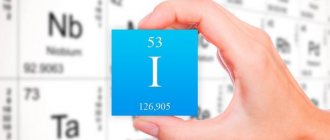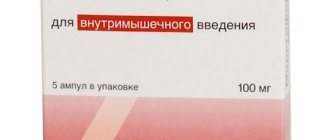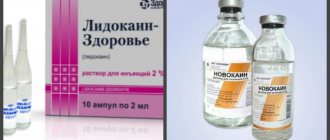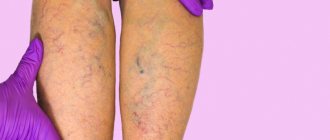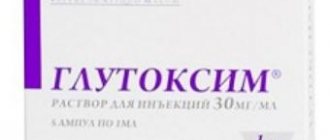Pharmacological properties of the drug Omnipaque
iohexol N,N-Bis(2,3-dihydroxypropyl)-5-[N-(2,3-dihydroxypropyl)acetamido]-2,4,6-triiodoisophthalamide,5-[acetyl(2,3-dihydroxypropyl)amino] -N,N-bis(2,3-dihydroxypropyl)-2,4,6-triiodo-1,3-benzenedicarboxamide) is a nonionic triiodinated water-soluble radiocontrast agent. The values of osmolarity and viscosity of the drug are given in the table:
Iodine concentration, mg/ml | Osmolarity, osmol/kg H2O at 37 °C | Viscosity (mPa•s) at 20 °C | Viscosity (mPa•s) at 37 °C |
| 180 240 300 350 | 0,36 0,51 0,64 0,78 | 3,2 5,6 11,6 23,3 | 2,0 3,3 6,1 10,6 |
In a study of healthy individuals after intravenous injection of Omnipaque, no significant deviations were found in most hemodynamic parameters, clinical-biochemical parameters and coagulation parameters. The time to achieve maximum radiopacity with conventional myelography is up to 30 minutes (after 1 hour it is no longer visualized). With computed tomography (CT), visualization of contrast in the thoracic region is possible for 1 hour, in the cervical region - about 2 hours, in the basal cisterns - 3-4 hours. Contrast of joint spaces, the uterine cavity, fallopian tubes, peritoneal protrusions, pancreatic and bile ducts, bladder is achieved immediately after administration of the drug. Almost 100% of iohexol administered intravenously with normal renal function is excreted unchanged from the body in the urine within 24 hours. The maximum concentration of iohexol in urine is established 1 hour after injection. The half-life of the drug in patients with normal renal function is 2 hours. Metabolites of the drug have not been established. The binding of iohexol to plasma proteins has no clinical significance (less than 2%), and therefore may not be taken into account. When administered intrathecally, it is absorbed from the CSF into the bloodstream and completely excreted by the kidneys (about 88% during the first day). Renal clearance - 99 ml/min., total clearance - 109 ml/min. The maximum concentration in the blood is 119 mcg/ml, the time to reach the maximum concentration in the blood is 2–6 hours. The volume of distribution is 157 ml/kg. The half-life is 3–4 hours.
Omnipack
Active substance:
Iohexol*
Pharmgroup:
X-ray contrast agents
Average price in pharmacies
| Name | Manufacturer | average price |
| Omnipack 300 mg iodine/ml 50 ml n10 bottle solution d/in | JII HEALTHCEA | 7489.00 |
Analogs for the active substance:Iohexol Unihexol | Application area:Vasography Venography Biliary tract imaging Blood flow visualization Imaging of the chest organs Liver imaging using invasive techniques Ultrasound imaging of the liver Visualization of the fallopian tubes Intra-arterial angiography Intravenous angiography Intravenous urography Intravenous/intraarterial digital subtraction angiography Gastroscopy Degassing of the intestines before diagnostic studies Degassing of the intestines before x-ray examination Diagnosis of the gastrointestinal tract Diagnosis of stroke Diagnosis of bleeding from the small intestine Diagnosis of focal liver pathology Diagnosis of secretory ability and acid-forming function of the stomach Diagnostic intervention on the colon Digital subtraction angiography Doppler echocardiography Duodenal sounding Duodenoscopy Isotope scintigrams of the liver Instrumental studies of the abdominal organs Intraoperative cholangiography Irrigoscopy Study of gastric secretion Gastrointestinal tract examination Study of the acid-forming function of the stomach Study of collateral circulation Examination of the aortic root and arch Study of gastric secretory function Heart function test Cardioangiography Cardiography Cinema angiography Colonoscopy Computed tomography of the liver Computed tomography of the heart Contrast aortography Contrast hysterosalpingoechography Contrast echocardiography Monitoring the effectiveness of lithotripsy Coronary angiography Coronary angiography CT myelography Laparocentesis Lymphography Magnetic resonance imaging of the liver Myelography cervical Victory cystourography MR angiography General myelography One-dimensional Doppler sound study of blood flow AV block localization determination Determination of the degree of hypersecretion in duodenal ulcers Panendoscopy Peripheral arteriography Perfusion imaging (scintography) of the myocardium Cardiac perfusion studies Hepatosplenic scanogram Esophageal manometry Vein plethysmography Damage to great vessels Preparing for diagnostic tests Preparation for X-ray and instrumental methods of examining the abdominal cavity Preparation for x-ray and ultrasound examination of the abdominal organs Preparation for x-ray or endoscopic examination of the gastrointestinal tract Preparation for X-ray examination of the gastrointestinal tract with contrast Preparation for X-ray examination of the gastrointestinal tract using barium Preparation for X-ray examination and ultrasound of the abdominal organs Preparation for X-ray examination or ultrasound of the abdominal organs Preparation for ultrasound and x-ray examination of the abdominal organs Preparation for endoscopic examinations of the lower colon Preparation for endoscopic or x-ray examination of the lower intestine Preparation of the lower gastrointestinal tract for endoscopic examination Preparation of the colon for instrumental and x-ray examinations Preparing the colon for x-ray and endoscopic examination Lumbar myelography Sigmoidoscopy Rectoscopy X-ray of the left atrium X-ray of the right ventricle X-ray of the gastrointestinal tract X-ray of blood vessels X-ray of the heart X-ray diagnosis of esophageal achalasia X-ray diagnosis of gastrointestinal diseases |
Use of the drug Omnipaque
For intravenous, intravenous, intrathecal, intracavitary, oral and rectal administration in adults and children. When administering the drug, the patient should be in a horizontal position. The dose of the drug depends on the type of study and its technique. There are no significant differences with other radiopaque agents, but you can focus on the following dosing methods: Intravascular administration
Indications | Iodine concentration, mg/ml | Volume | Comments |
| Urography | When performing high-dose urography, higher doses may be used | ||
| Adults | 300 or 350 | 40–80 ml | |
| Children ≤7 kg | 240 or 300 | 4–3 ml/kg | |
| Children 7 kg | 240 or 300 | 3–2 ml/kg (but not more than 40 ml) | |
| Arteriography | |||
| Aortography (arches) | 300 | 30–40 ml per injection | |
| Selective cerebral angiography | 300 | 5–10 ml per injection | |
| Aortography | 350 | 40–60 ml per injection | |
| Femoral angiography | 300 or 350 | 30–50 ml per injection | |
| Other types of angiography | 300 | Depending on the type of study | |
| Phlebography of the lower extremities | 240 or 300 | 20–100 ml per limb | |
| Cardioangiography | |||
| Adults Injection into the left ventricle and aortic root | 350 | 30–60 ml per injection | |
| Selective coronary angiography | 350 | 4–8 ml per injection | |
| Children | 300 or 350 | Depending on age, body weight and pathology | |
| Digital subtraction angiography | Depending on the injection site, larger volumes (up to 30 ml) may be used. | ||
| V/a | 240, 300 | 1–15 ml per injection | |
| IV | 300, 350 | 20–60 ml per injection | |
| Contrast enhancement at | |||
| Adults | 240,300, 350 | From 250, 200, 150 ml respectively | The total amount of iodine is usually 30–60 g |
| Children | 240 | 2–3 ml/kg body weight (up to 40 ml) | In some cases, it is possible to administer up to 100 ml |
| 300 | 1–3 ml/kg body weight (up to 40 ml) |
Subarachnoid injection
Indications | Iodine concentration, mg/ml | Volume | Comments |
| Myelography | |||
| Lumbar and thoracic (lumbar injection) | 180 or 240 | 10–15 and 8–12 ml respectively | Lumbar puncture |
| Cervical (lumbar injection) | 240 or 300 | 10–12 and 7–10 ml | Lumbar puncture |
| 240 or 300 | 6–10 and 6–8 ml, respectively | Lateral cervical puncture | |
| CT cisternography | 180 or 240 | 2–6 and 4–12 ml | Lumbar puncture |
| Myelography in children | |||
| Up to 2 years | 180 | 2–6 ml | |
| 2–6 years | 180 | 4–8 ml | |
| Over 6 years old | 180 | 6–12 ml |
To minimize the risk of side effects, the total dose of iodine should not exceed 3 g.
Intracavitary administration
Indications | Iodine concentration, mg/ml | Volume | Comments |
| Aortography | 240, 300, 350 | From 5 to 20.15, 10 ml respectively | |
| Endoscopic retrograde cholangiopancreatography | 240 | 20–50 ml | |
| Herniography | 240 or 300 | 50 ml | The volume of injection depends on the volume of the hernia |
| Hysterosalpingography | 240 or 300 | From 15 to 50, 25 ml respectively | |
| Sielography | — | 0.5–2 ml | |
| Gastrointestinal studies Oral administration | |||
| Adults | 180, 240, 350 | The choice is made individually | |
| Children | |||
| Esophagus | 300, 350 | 2–4 ml/kg body weight | |
| Stomach | 140 | 4–5 ml/kg body weight | |
| Premature babies | 350 | 2–4 ml/kg body weight | Maximum dose 50 ml |
| Rectal administration children | 140 or higher doses diluted with water to a concentration of 100–150 mg/ml | 5–10 ml/kg body weight | Example: dilute Omnipaque 240, 300 or 350 with water 1:1 and 1:2 |
| CT enhancement Oral contrast | Example: dilute Omnipaque 300 or 350 with water 1:50 | ||
| Adults | Dilute with water to a concentration of about 6 mg/ml | 800–2000 ml of solution over a certain period of time | |
| Children | Dilute with water to a concentration of about 6 mg/ml | 15/20 ml/kg body weight | |
| Rectal administration | Dilute with water to a concentration of about 6 mg/ml | Selected individually |
Release form and composition
Omnipack is available in the form of a clear, colorless or slightly yellowish solution in bottles of 10, 15, 20, 50 and 100 ml. The international non-proprietary name of the product is Yohexol; it uses iodine as an active component.
The concentration of iodine in 1 milliliter of Omnipaque solution is 180, 240, 300 or 350 mg, iohexol, respectively, is 388, 518, 647 or 755 mg.
Auxiliary components of the drug:
- Hydrochloric acid;
- Trometamol;
- Sodium calcium edetate (EDTA);
- Water for injections.
Side effects of the drug Omnipaque
Side effects with the administration of non-ionic radiocontrast agents are usually moderate or mild, reversible and reported less frequently than with ionic contrast agents. Moderate general symptoms may occur, such as a feeling of warmth throughout the body or a transient metallic taste in the mouth. Feelings of discomfort and abdominal pain are very rare (≤1:1000), nausea and vomiting are also very rare (from 1:1000 to ≤1:100). Hypersensitivity reactions may occur, usually manifesting as mild respiratory and cutaneous reactions such as shortness of breath, rash, erythema, urticaria, pruritus and angioedema. They can develop either immediately after administration of the drug or several days later. Hypotension and fever may occur. There are reports of toxic skin reactions. Severe manifestations of hypersensitivity reactions, such as laryngeal edema, bronchospasm, pulmonary edema and anaphylactic shock, develop very rarely. Headache, nausea, vomiting or dizziness are possible with intrathecal administration and are associated with a decrease in pressure in the subarachnoid space due to the outflow of cerebrospinal fluid through the puncture site. Anaphylactoid reactions can occur regardless of the dose and route of administration. A severe reaction may begin with minor manifestations of hypersensitivity. In this case, it is necessary to immediately stop administering the drug and begin the necessary emergency therapy with intravascular administration of drugs. In patients taking β-adrenergic blockers, manifestations of anaphylaxis may be atypical and mistaken for vagal reactions. Vasovagal reactions in the form of arterial hypotension and bradycardia are observed very rarely. Severe skin reactions (Stevens-Johnson syndrome and toxic epidermal necrolysis) are very rare. Sometimes hyperthermia with the development of convulsions may occur. Iodism is an extremely rare reaction following the administration of iodinated contrast media. It can manifest itself as an increase in the size and pain of the salivary glands for up to 10 days after the study.
Side effects
The following side effects may occur when using the drug in any of the ways:
- Often: transient metallic taste in the mouth, feeling of warmth;
- Rarely: hypersensitivity reactions (urticaria, itching, rash, erythema, shortness of breath, angioedema), nausea and/or vomiting, abdominal pain/discomfort;
- Very rare: iodism, Stevens-Johnson syndrome, fever with convulsions, pulmonary edema, laryngeal edema, bronchospasm, fever, anaphylactic shock, toxic epidermal necrolysis, hypotension, bradycardia, anaphylactoid reactions.
Possible side effects that occur with one or another method of using Omnipack:
- Subarachnoid administration: paresthesia, pain in the limbs, neck and back, headache, vertigo, aseptic meningitis;
- Intra-arterial administration: arterial spasm, distal pain, cardiac arrhythmia, myocardial ischemia, decreased myocardial contractile function, neurological reactions, transient increase in serum creatinine, renal failure;
- Intravenous administration: post-phlebographic thrombosis or thrombophlebitis; in isolated cases - arthralgia;
- Intrathecal administration: headache, vertigo; very rarely - changes in the electroencephalogram, cramps and pain in the legs, paresthesia and radicular pain at the puncture site, transient brain dysfunction (sensory/motor dysfunction, disorientation, convulsions), signs of irritation of the dura mater (meningismus, photophobia);
- Intracavitary administration: arthritis, gastrointestinal disorders, pancreatitis.
Special instructions for the use of the drug Omnipaque
Do not mix the drug in the same syringe with other diagnostic and medicinal products. Before using a radiocontrast agent, it is necessary to obtain accurate information about the patient, taking into account the results of laboratory and instrumental research methods (serum creatinine level, ECG, history of allergic reactions). Before the study, the patient's fluid and electrolyte balance must be restored. A history of allergies, asthma, and side effects to iodine-containing contrast agents requires increased attention. In these cases, it is necessary to consider the possibility of premedication with corticosteroids and antihistamines. The risk of severe side effects when using Omnipaque is low. However, iodinated contrast agents may cause anaphylactic reactions or other manifestations of hypersensitivity. For this reason, it is necessary to foresee the sequence of treatment measures in case of their occurrence and have the necessary drugs and equipment available. It is advisable to install an IV catheter during the X-ray contrast study in order to facilitate rapid IV administration of medications. Compared to ionic drugs, non-ionic radiocontrast agents have less effect in vitro on the blood coagulation system. When conducting angiographic studies, you should carefully adhere to their techniques and frequently flush the catheters to minimize the risk of thromboembolism caused by the intervention. Before and after administration of the contrast agent, it is necessary to ensure adequate hydration of the body. This is especially important in patients with multiple myeloma, diabetes mellitus, impaired renal function, as well as in children and the elderly. In children under one year of age, especially newborns, hemodynamic and electrolyte imbalances occur especially often. Caution should be exercised when studying patients with severe cardiovascular disease and pulmonary hypertension due to the risk of developing cardiac arrhythmias and hemodynamics. Patients with acute cerebral pathology, brain tumors and epilepsy are prone to developing seizures and require special attention. There is an increased risk of developing seizures and neurological reactions in drug addicts and alcoholics. There have been rare cases of temporary decrease in hearing acuity or deafness after myelography, which was probably associated with a drop in cerebrospinal fluid pressure after lumbar puncture. To prevent the development of acute renal failure associated with the administration of a contrast agent, special caution is required when studying patients who already have impaired renal function and diabetes mellitus. The same applies to the study of patients with paraproteinemias (myeloma, Waldenström's macroglobulinemia). Measures to prevent the development of side effects:
- identification of patients at risk;
- ensuring adequate hydration (if necessary, this can be achieved with a constant IV infusion, started before the contrast agent is administered and continued until it is completely eliminated by the kidneys);
- prevention of additional load on the kidneys that occurs when using nephrotoxic drugs, drugs for oral cholecystography, when clamping the renal arteries, angioplasty of the renal arteries, surgical interventions until the contrast agent is completely removed from the body;
- Repeated studies using radiocontrast agents should be performed after complete normalization of renal function after the last administration of the drug.
Particular caution should be observed when conducting studies in patients with severe combined impairment of renal and liver function, since they experience a significant decrease in the clearance of contrast agents. It is possible to perform studies using radiocontrast agents in patients undergoing hemodialysis, provided that dialysis is carried out immediately after the study. The administration of iodine-containing radiocontrast agents may increase the symptoms of myasthenia gravis. When performing invasive studies and interventions in patients with pheochromocytoma, prophylactic use of α-adrenergic receptor blockers is necessary to prevent hypertensive crises. Particular care is required when assessing patients with hyperthyroidism. In patients with multinodular goiter after administration of iodine-containing contrast agents, there is a risk of developing hyperthyroidism. One should remember about the possibility of developing transient hyperthyroidism in premature infants when contrast media are administered. After administration of the contrast agent, the patient should be observed for at least 30 minutes, since most adverse reactions occur during this period. However, longer-term side effects are also possible. Intrathecal administration After performing myelography, the patient should be at rest for at least 1 hour, lying down with his head and chest raised 20°. After this, the patient can be transferred to outpatient mode, but bending should be avoided. While maintaining bed rest, the elevated position of the head and chest should be maintained for the first 6 hours. If a low threshold for convulsive readiness is suspected, the patient must be observed during this period. Outpatients should not be left without observation during the first 24 hours after the study. The drug affects the speed and accuracy of reactions, therefore, during the first 24 hours after intrathecal administration of contrast media, you must refrain from driving.
Drug interactions
Iohexol enhances the nephrotoxic properties of other concomitantly used drugs.
In patients receiving tricyclic antidepressants, analeptics, central nervous system stimulants, monoamine oxidase inhibitors, phenothiazine derivatives and other antipsychotics (neuroleptics), iohexol helps lower the seizure threshold, which may result in epileptic seizures.
With the simultaneous use of antihypertensive drugs (including beta-blockers), the likelihood of developing arterial hypotension increases.
Interactions of the drug Omnipaque
The use of contrast media in diabetic patients taking biguanides (metformin) can lead to reversible renal impairment and lactic acidosis. To prevent them, it is necessary to stop taking biguanides 48 hours before the study and resume taking them after complete stabilization of renal function. Patients who took interleukin-2 less than 2 weeks before the study are prone to late adverse reactions (flu-like conditions or skin reactions). Omnipaque (for intrathecal administration) is incompatible with GCS. Phenothiazane derivatives and other antipsychotics, MAO inhibitors, tetracyclic antidepressants, central nervous system stimulants, analeptics reduce the epileptic threshold and increase the risk of developing convulsive seizures. β-adrenergic blockers and other antihypertensive drugs increase the likelihood of developing arterial hypotension.
Contraindications
The product is contraindicated for pregnant women, patients with hypersensitivity to the components included in the product, as well as for local or systemic infections.
Additional contraindications to the subarachnoid use of Omnipaque are:
- Bacterial infections;
- Technical failure when attempting to perform myelography (in such cases, immediate re-examination is prohibited);
- Epilepsy.
The instructions for Omnipack indicate that the solution should be administered with extreme caution in the following conditions:
- Hay fever (hay fever);
- Failure of kidney and/or liver function;
- Bronchial asthma;
- Food allergies;
- Dehydration;
- Thyrotoxicosis;
- Diabetes;
- Myelomatosis;
- Decompensated heart and vascular diseases (including chronic heart failure);
- Alcohol addiction;
- Multiple sclerosis;
- Sickle cell anemia;
- Buerger's disease (thromboangiitis obliterans);
- Pheochromocytoma;
- Severe atherosclerosis.
- Acute thrombophlebitis.
Omnipaque should also be used with caution during breastfeeding and during diagnostic procedures in elderly patients.
Lumbar puncture using Omnipaque should be performed with caution in case of systemic or local infections.
Overdose of the drug Omnipaque, symptoms and treatment
The risk of overdose is minimal if more than 2000 mg/kg body weight of iodine is not administered to the patient within a short period of time. A prolonged procedure using the drug in high doses may affect renal function (half-life - 2 hours). Accidental overdose of the drug can occur during complex angiographic procedures in children, especially with repeated administration in high doses. Symptoms of overdose are cyanosis, bradycardia, acidosis, pulmonary hemorrhage, insomnia or drowsiness, weakness, fatigue, stupor, epileptic syndrome, coma, mental disturbances (hallucinations, depersonalization, disorientation, depression, amnesia), photophobia, meningism, hyperreflexia or areflexia , paralysis, tremor. In case of overdose, it is necessary to correct water-electrolyte imbalances. Renal function should be monitored over the next 3 days. If necessary, use hemodialysis to remove the drug. There is no specific antidote. For therapeutic purposes, diazepam is administered at a dose of 10 mg intravenously slowly, 20–30 minutes after the cessation of the seizure attack - phenobarbital at a dose of 200 mg intramuscularly. Monitor and support vital functions and provide symptomatic therapy.
Instructions:
1 ml of injection solution contains iodine 140, 180, 240, 300 or 350 mg; in glass bottles of 50 and 200 ml, in a box of 10 or 6 bottles, respectively, or in polypropylene bottles of 50 ml, in a box of 10 bottles (140 mg), or in glass and polypropylene bottles of 10, 15 and 50 ml, in a box of 10 bottles (180 mg), or in glass bottles of 10, 20, 50 and 200 ml, in a box of 10, 6 and 25 (20 ml), 10 and 6 bottles, respectively, or in polypropylene bottles of 10, 20 and 50 ml, in box of 10 bottles (240 mg), or in glass bottles of 10, 20, 50 and 100 ml, in a box of 10, 6 and 25 (20 ml), 10 and 6 bottles, respectively, or in polypropylene bottles of 10, 20, 40 and 50 ml, in a box of 10 bottles (300 mg), or in glass bottles of 10, 20, 50, 100 and 200 ml, in a box of 10, 25, 10, 10 and 6 bottles, respectively, or in polypropylene bottles of 20, 40 and 50 ml, box contains 10 bottles (350 mg).
The osmolarity and viscosity values of Omnipaque are given in the table:
| Active Ingredient | Concentration, mg iodine/ml | Iohexol content, mg/ml | Osmolarity*, Osm/kg H2O at 37 °C | Viscosity, mPa/s at 20 °C | Viscosity, mPa/s at 37 °C |
| Iohexol | 140 | 302 | 0,29 | 2,3 | 1,5 |
| Iohexol | 180 | 388 | 0,36 | 3,2 | 2,0 |
| Iohexol | 240 | 518 | 0,51 | 5,6 | 3,3 |
| Iohexol | 300 | 647 | 0,64 | 11,6 | 6,1 |
| Iohexol | 350 | 755 | 0,78 | 23,3 | 10,6 |
* Determination method: pressure vapor osmometry
Characteristic
Non-ionic, monomeric, triiodinated, water-soluble radiocontrast agent. Sterile aqueous solution, colorless or slightly yellowish.
pharmachologic effect
Pharmacological action: radiopaque.
Organically bound iodine (as part of a non-ionic triiodine-containing water-soluble compound) absorbs x-rays and visualizes blood vessels, cavities and tissues on x-rays.
Pharmacokinetics
Cmax is determined approximately 1 hour after injection. T1/2 is about 2 hours. It is completely excreted unchanged by the kidneys within 24 hours.
Indications for the drug Omnipaque
Cardioangiography, arteriography, urography, phlebography, contrast enhancement in computed tomography; myelography (lumbar, thoracic and cervical), computed tomography-cisternography after subarachnoid injection; arthrography, endoscopic retrograde pancreatography and cholangiopancreatography, salpingography, sialography; gastrointestinal tract examination.
Contraindications
Hypersensitivity (including to other iodine-containing drugs), obvious thyrotoxicosis, history of serious adverse reactions to Omnipaque.
Use during pregnancy and breastfeeding
During pregnancy, it is possible only in cases where the benefits of use outweigh the risks. You should refrain from breastfeeding for 24 hours after administration of Omnipaque.
Side effects of the drug Omnipaque
Regardless of the route of administration - a feeling of warmth, a transient metallic taste in the mouth, rarely - discomfort or pain in the abdomen, nausea, vomiting, hypersensitivity reactions (shortness of breath, rash, erythema, itching, urticaria, angioedema), very rarely - hypotension, fever , laryngeal edema, bronchospasm, pulmonary edema, anaphylactic shock, anaphylactoid reactions, bradycardia, Stevens-Johnson syndrome, toxic epidermal necrosis, increased body temperature with convulsions, iodism; with subarachnoid administration - dizziness, headache, pain in the back, neck, limbs, paresthesia, aseptic meningitis; with intravenous administration - distal pain, transient increase in serum creatinine, renal failure, arterial spasm, neurological reactions, cardiac arrhythmia, decreased myocardial contractile function, myocardial ischemia; with intravenous administration - post-phlebographic thrombophlebitis or thrombosis, arthralgia (isolated cases); with intrathecal administration - headache, dizziness, very rarely - pain, paresthesia and radicular pain at the puncture site, cramps and pain in the legs, signs of irritation of the dura mater (photophobia, meningism), transient brain dysfunction (convulsions, disorientation, motor or sensory dysfunction), electroencephalogram changes; with intracavitary administration - pancreatitis, gastrointestinal disorders, arthritis.
Directions for use and doses
IV, IV, endolumbar, subarachnoid, intracavitary, orally. Doses vary depending on the type of study, the methodology and technique used to perform the study, the age and body weight of the patient, and cardiac output. Recommended average iodine concentrations for intravenous administration are 240, 300 or 350 mg/ml, for intravenous administration - 140, 240, 300 or 350 mg/ml, for intrathecal administration - 180, 240 or 300 mg/ml, intracavitary - 240 or 300 mg/ml, orally - 180, 240, 300 or 350 mg/ml.
Below are the dosage tables.
Intravenous administration
| Indication | Concentration, mg iodine/ml | Volume | Notes |
| Urography | |||
| adults | 300 | 40–80 ml | In some cases, it is possible to administer more than 80 ml |
| 350 | 40–80 ml | ||
| children | 240 | 4 ml/kg | |
| 300 | 3 ml/kg | ||
| children > 7 kg | 240 | 3 ml/kg | |
| 300 | 2 ml/kg (max. 40 ml) | ||
| Phlebography (lower limbs) | 200 | 20–100 ml per limb | |
| 240 | |||
| 300 | |||
| Digital subtraction angiography | 300 | 20–60 ml per injection | |
| 350 | |||
| CT enhancement | |||
| adults | 140 | 100–400 ml | The total amount of iodine is usually 30–60 g |
| 200 | 100–300 ml | ||
| 240 | 100–250 ml | ||
| 300 | 100–200 ml | ||
| 350 | 100–150 ml | ||
| children | 240 | 2–3 ml/kg – up to 40 ml | In some cases, it is possible to administer up to 100 ml |
| 300 | 1–3 ml/kg – up to 40 ml | ||
Intra-arterial administration
| Indication | Concentration, mg iodine/ml | Volume, ml per injection | Notes |
| Angiography | |||
| Thoracic aorta | 300 | 30–40 | The volume per injection depends on the injection site |
| Selective cerebral angiography | 300 | 5–10 | |
| Aortography | 350 | 40–60 | |
| Angiography of the femoral arteries | 300 | 30–50 | |
| Other types | 300 | depends on the type of study | |
| Cardioangiography | |||
| adults: | |||
| injection into the left ventricle and aortic root | 350 | 30–60 | |
| selective coronary angiography | 350 | 4–8 | |
| children: | 300 | Depending on age, body weight and disease (max. 8 ml/kg) | |
| 350 | |||
| Digital subtraction angiography | 140 | 1–15 | Depending on the injection site, larger volumes (up to 30 ml) can be used. |
| 200 | 1–15 | ||
| 240 | 1–15 | ||
| 300 | 1–15 | ||
Intrathecal administration
| Indication | Concentration, mg iodine/ml | Volume, ml |
| Lumbar and thoracic myelography (lumbar injection) | 180 | 10–15 |
| 200 | 10–15 | |
| 8–12 | ||
| 240 | 10–12 | |
| 7–10 | ||
| Cervical myelography (lumbar injection) | 240 | 6–10 |
| 300 | 6–8 | |
| Cervical myelography (lumbar injection) | 240 | 5–15 |
| 300 | 5–15 | |
| 4–12 | ||
| CT cisternography (lumbar injection) | 180 | |
| Myelography in children | ||
| 180 | 2–6 | |
| 2–6 years | 180 | 4–8 |
| > 6 years | 180 | 6–12 |
To minimize the risk of adverse reactions, the total dose of iodine should not exceed 3 g.
Body cavities
| Indication | Concentration, mg iodine/ml | Volume | Notes |
| Arthrography | 200 | 5–20 ml | |
| 240 | 5–20 ml | ||
| 300 | 5–15 ml | ||
| 350 | 5–10 ml | ||
| Retrograde pancreato- and cholangiography | 240 | 20–50 ml | |
| Herniography | 240 | 50 ml | The volume of injection depends on the volume of the hernia |
| Hysterosalpingography | 240 | 15–50 ml | |
| 300 | 15–25 ml | ||
| Sialography | 240 | 0.5–2 ml | |
| 300 | 0.5–2 ml | ||
| Gastrointestinal studies | |||
| Oral contrast | |||
| Adults | 180 | selected individually | |
| 240 | |||
| 300 | |||
| Children | |||
| – esophagus | 300 | 2–4 ml/kg | |
| 350 | 2–4 ml/kg | ||
| - stomach | 140 | 4–5 ml/kg | |
| Premature babies | 350 | 2–4 ml/kg | |
| Rectal administration | |||
| - children | 140 | 5–10 ml/kg | |
| higher, diluted with water to 100–150 mg iodine/ml | 5–10 ml/kg | For example: dilute Omnipaque 240, 300 or 350 with water 1:1 or 1:2 | |
| CT enhancement | |||
| Oral contrast | |||
| Adults | Dilute with water to a concentration of approximately 6 mg iodine/ml | 800–2000 ml of solution over a certain period | For example: dilute Omnipaque 300 or 350 with water 1:50 |
| Children | Dilute with water to a concentration of approximately 6 mg iodine/ml | 15–20 ml/kg | |
| Rectal administration | |||
| Children | Dilute with water to a concentration of approximately 6 mg iodine/ml | selected individually | |
Precautionary measures
Diagnostic procedures using iohexol can only be carried out in a hospital setting with an intensive care unit and resuscitation unit by specially trained personnel with sufficient experience in performing this type of research (it is desirable to have an intravenous catheter during the X-ray contrast examination in order to facilitate rapid intravenous administration of the necessary medications). Measures should be taken to prevent adverse reactions: identification of patients at high risk; ensuring adequate hydration; preventing additional stress on the kidneys (use of nephrotoxic drugs or oral cholecystography agents, clamping or angioplasty of the renal arteries, surgery) until the contrast agent is removed from the body; Repeated radiopaque studies should not be performed until renal function returns to baseline. It is necessary to monitor the patient for at least 30 minutes after administration of the contrast agent. The study is carried out with special caution if there is a history of allergies, asthma, cardiovascular diseases, pulmonary hypertension, acute cerebral pathology, brain tumors, epilepsy, alcoholism, drug addiction, severe liver and kidney dysfunction, diabetes mellitus, hyperthyroidism, paraproteinemia. It should be borne in mind that the use of contrast agents in diabetics taking biguanides (metformin) can lead to transient impairment of renal function and the development of lactic acidosis (it is necessary to stop taking biguanides 48 hours before the study and resume after complete stabilization of renal function). Interleukin-2 taken by the patient less than 2 weeks before the study may increase the incidence of delayed adverse reactions (flu-like conditions or skin reactions). When performing X-ray contrast studies in patients undergoing hemodialysis, it is necessary to carry out dialysis immediately after the study. When performing invasive studies and interventions in patients with pheochromocytoma, prophylactic use of alpha-blockers is necessary to prevent hypertensive crises. In cases of inflammation or tissue necrosis during extravascular administration, cold and an elevated position of the limb are recommended; in cases of compression symptoms, surgical decompression is recommended. Prescribe with caution to the elderly and children due to the high risk of severe adverse reactions and the possibility of increased dehydration. When performing angiographic studies, careful technique should be followed and catheters should be flushed frequently (eg, with heparinized saline) to minimize the risk of procedure-related thrombosis and embolism. After myelography, the patient should be at rest for at least 1 hour, lying on his back with his head elevated. While maintaining bed rest, the elevated position of the head and chest should be maintained for the first 6 hours, and the patient must be monitored throughout the day. It is not recommended to drive a car or use any other machinery during the first 24 hours after intrathecal administration.
special instructions
You should use a separate syringe and needle for administration and do not mix it with other medications. Affects the results of tests to determine thyroid function. High concentrations of contrast agent in plasma or urine may affect the results of biochemical tests to determine the concentration of bilirubin, proteins, or inorganic substances (for example, iron, copper, calcium, and phosphate).
Storage conditions for the drug Omnipaque
In a place protected from light and secondary X-ray radiation, at room temperature no higher than 30 °C.
Indications for use
- Oral administration: gastrointestinal studies;
- Intracavitary application: retrograde endoscopic cholangiopancreatography, sialography, arthrography, herniography, retrograde endoscopic pancreatography, hysterosalpingography;
- Subarachnoid application: thoracic myelography, computed tomography of the basal cisterns, lumbar myelography, cervical myelography;
- Intravascular use: angiocardiography, phlebography, aortography, urography; angiography of the neck, head, lungs, abdominal cavity, brain, kidneys; computed tomography (to increase resolution).
